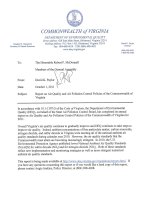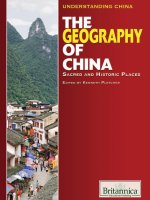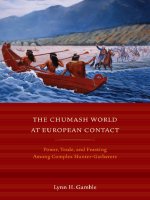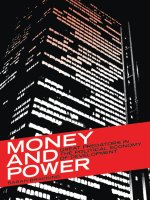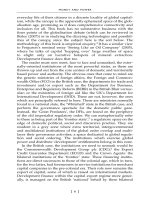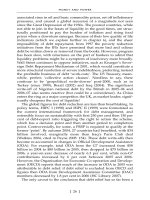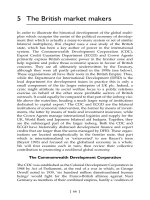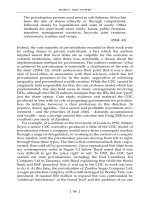power, perception and policymaking the foreign policies of the us and the eu towards china
Bạn đang xem bản rút gọn của tài liệu. Xem và tải ngay bản đầy đủ của tài liệu tại đây (8.92 MB, 368 trang )
Glasgow Theses Service
Brown, Scott Alexander William (2014) Power, perception and
policymaking: the foreign policies of the US and the EU towards
China. PhD thesis.
Copyright and moral rights for this thesis are retained by the author
A copy can be downloaded for personal non-commercial research or
study, without prior permission or charge
This thesis cannot be reproduced or quoted extensively from without first
obtaining permission in writing from the Author
The content must not be changed in any way or sold commercially in any
format or medium without the formal permission of the Author
When referring to this work, full bibliographic details including the
author, title, awarding institution and date of the thesis must be given
Scott Alexander William Brown, MA (Hons), MSc.
Submitted in fulfilment of the requirements for the Degree of
Doctor of Politics
School of Social and Political Sciences
College of Social Sciences
University of Glasgow
April 2014
i
China’s rise has put it on a trajectory to overtake the international system’s dominant powers –
the United States of America (US) and the European Union (EU) – at some point this century.
Some observers conclude that the historical pattern of such transitions catalysing great power
conflict is likely to continue with China’s ascendancy. Power-transition theory (PTT)
anticipates that the established powers will strive to maintain the status quo by extending their
relative power advantage over the rising challenger and curtailing its power where possible.
Yet the actual responses of the US and the EU have not conformed to these expectations;
instead, they have both largely welcomed China’s rise and sought to integrate it into the
international system. We can see that policymakers continually express interpretations of
China’s rise which we would not expect to find if the logic of PTT prevailed. This raises a
question: How have different interpretations of the ‘rise of China’ influenced the foreign
policies of the US and the EU towards China?
I argue that varied perceptions of the implications of China’s rise have shaped policy
preferences in ways that are inconsistent with concerns over the threat of an impending power-
transition. Policy discourse at key junctures in bilateral relations revealed that ‘China’s rise’ is
actually a contested notion and that the different interpretations in play at that point in time
affect the policymaking process in ways that cannot be accounted for from state-centric
perspectives. While China’s growing power and relations with these actors have been widely
studied, little attention is paid to how competing interpretations of China’s rise impact upon
policymakers’ preferences and the eventual responses. Despite the growing prevalence of
threat rhetoric (at least in the US), China’s rise is often conceptualised by key policymakers as
presenting considerable economic and political opportunities. In the EU, perceptions of
economic and political opportunities have not been challenged by threat interpretations and
thus its overall approach has been informed by the former with little substantive debate
amongst key actors.
ii
Abstract
i
List of Figures
iv
List of Tables
v
Acknowledgements
vi
Declaration
viii
Abbreviations
ix
Introduction
1
1. Focus of the Project and Research Question
1
2. Case Selection and Timeframe of Analysis
6
3. Analytical Approach, Methodology and Sources
13
The Analytical Framework
13
Methodology and Sources
17
4. Main Findings and Contribution
19
5. Structure of the Thesis
24
Chapter One: Handling China’s Rise: Explanations of Foreign Policy in the Academic
Literature
26
1.1 Introduction
26
1.2 Power-Transition Theory
27
1.3 US-China Relations
33
1.4 EU-China Relations
40
1.5 The Arms Embargo Debate and US-EU-China Relations
48
The Arms Embargo Debate
48
US-EU-China Relations
51
1.6 Perceptions and Policymaking
53
1.7 Conclusion
58
Chapter Two: Interpretations of the ‘Rise’ of China
60
2.1 Introduction
60
2.2 Military Threat
62
2.3 Military Non-Threat
71
2.4 Economic Threat
80
2.5 Economic Opportunity
88
2.6 Normative Threat
97
2.7 Political Opportunity
105
2.8 Conclusion
111
Chapter Three: Debating the Rise of China in US Foreign Policy
112
3.1 Introduction
112
3.2 US Foreign Policy Subsystems
114
3.3 US Responses to Key Events in the Bilateral Relationship
116
Tiananmen Crackdown
120
MFN Linkage/Delinkage
127
Taiwan Strait Crisis
133
WTO Accession & PNTR
139
EP-3 Incident
146
Anti-Satellite Test
152
3.4 Interpretations of China’s Rise and Decision-Making in the US’ Foreign Policies
159
iii
3.5 Conclusion
164
Chapter Four: Debating the Rise of China in European Foreign Policy
167
4.1 Introduction
167
4,2 EU Foreign Policy Subsystems
169
4.3 EU Responses to Key Events in the Bilateral Relationship
171
Tiananmen Crackdown
176
Taiwan Strait Crisis
181
Human Rights Resolutions at the UNCHR
187
WTO Accession
193
The EU-China Strategic Partnership
199
MES
205
4.4 Interpretations of China’s Rise and Decision-Making in the EU’s Foreign Policies
211
4.5 Conclusion
216
Chapter Five: The Transatlantic Arms Embargo Debate: Diverging Interpretations of the
Rise of China
217
5.1 Introduction
217
5.2 PTT Expectations and Subsystems
219
5.3 The Origins, Substance and Development of the Embargoes, 1989-2003
221
The EU’s China Arms Embargo
221
The US’ Arms Embargo
226
5.4 The Diverging Interpretations of the Rise of China in the Arms Embargo Debate
228
Proposal to Lift
234
The Beginning of the Transatlantic Debate
240
The EU Pushes On
245
The Debate Heats Up
249
The Anti-Secession Law and the EU’s Change of Heart
256
5.5 Conclusion
262
Chapter Six: Conclusions
264
6.1 Introduction
264
6.2 Main Findings
265
6.3 Implications for the Literature
278
Arms Embargo Debate Literature
278
PTT and Wider IR Literature
279
FPA/EFP Literature
282
6.4 Final Comments
284
Appendix: Methodology and Sources
286
References
288
iv
2.1
Views on China Becoming as Militarily Powerful as the US, 2005
64
2.2
PRC Defence Expenditure, 1989-2009
68
2.3
US Estimates of China’s Military Expenditure, 1996-2008
69
2.4
PRC and US Defence Expenditure, 1989-2009
75
2.5
PRC and EU Defence Expenditure, 1989-2009
76
2.6
GDP of the PRC, US and EU in PPP Terms, 1989-2009
83
2.7
GDP Growth for the PRC, US and EU (% Change), 1989-2009
84
2.8
US and EU Trade Balance with the PRC, 1989-2009
85
2.9
US and EU Exports to the PRC, 1989-2009
92
2.10
GDP Per Capita in PPP Terms of the PRC, US and EU, 1989-2009
93
2.11
GDP Per Capita Growth for the PRC, US and EU (% Change), 1989-2009
94
2.12
Trade as a Percentage of GDP for the PRC, US and EU, 1989-2009
95
v
2.1
Summaries of Human Rights Reports, 1989-2009
103
3.1
Key Quotations from the US’ National Security Strategy Documents
118
4.1
Key Quotations from the EU’s Communication Documents
174
5.1
European Arms Exports to China, 1989-2008
224
5.2
Arms Exports of US, 1989-2008
228
6.1
Comparison of US and EU Responses to the Same Key Events
274
vi
Mere words cannot convey the depth of my gratitude towards those who have assisted me in
the production of this work or compensate them for their efforts. However, I would like to take
this opportunity to highlight the tremendous support I have had over the past few years. The
journey which led to this point really began in 2007 when studying for an MSc in International
Politics; Alasdair Young, as the course co-ordinator, supported my ambition to pursue a PhD
and agreed to be my supervisor and gave me faith in my own abilities. Even after moving to
Georgia, Alasdair retained his involvement in this thesis, for which I am thankful. Cian
O’Driscoll, also influential during my Masters year, joined as my supervisor in 2011 and I am
immensely grateful for his efforts. It is doubtful that I could have asked for a better
supervision team; it is no exaggeration to say that without their guidance this project would
not have come together. Their helpful feedback and constructive criticism has been crucial to
the development of my ideas.
I have been fortunate to be surrounded by an inspirational cohort of research students
throughout my studies. I am even more privileged to be able to call many of them good
friends. Ahmed, Aofei, Ariel, Dan, Elliot, Gordon, Hua, Kari, Karen, Kate, Koen, Meg, Senia,
and Valentina: thanks guys. A special mention goes to James Bilsland and Sam Robertshaw,
who have provided endless support, encouragement, conversation and entertaining distractions
as I worked through the writing up of the thesis. Outside of the PhD group, I thank Mark
Prestly for his continued friendship and trying to advance my understanding of organic
chemistry; and John Gallagher for putting me up (and putting up with me) in London whilst on
fieldwork and en route to and from conferences and fieldwork. The Politics staff at Glasgow
have continually provided me with helpful insights into my work and professional
development, especially in terms of my teaching. With respect to the latter, the administrative
staff – Caroline, Karen and Maggie – helped me extensively. Thanks also to the Politics
department at the University of Dundee for allowing me to use their facilities while writing up.
I am indebted to all those whom I interviewed during my fieldwork. There are far too many to
name, but I am grateful to all those who spoke to me and showed an interest in my work. The
thesis would be a shadow of its current self without their input, whether they have been
vii
directly cited or not. In addition, I extend my thanks to the helpful staff at the various libraries
and archives I visited. Financial support for fieldwork and conference attendance was
generously provided by: the Department of Politics/School of Social and Political Sciences at
Glasgow; the British International Studies Association; the European Union Studies
Association; the International Studies Association; the InBev-Baillet Latour Chair of European
Union-China Relations at the College of Europe; the McGlashan Charitable Trust; and the
University Association for Contemporary European Studies in partnership with the European
Commission.
To my immediate family, I am eternally thankful for their continued support, encouragement
and belief in my endeavours. My parents, Tommy and Nancy, in particular were supportive of
my decision to pursue my studies further, and I would not be where I am today without them. I
have also received support from my wider family including in-laws, who have shown a
continued interest in my project – especially in terms of when I would be finishing it. Ellie –
our Shih Tzu – has been a great companion and an excellent listener in the final months of
writing up.
Finally, and crucially, I thank Evonne, who was my girlfriend at the outset of my project and I
am now honoured to call my wife. Evonne encouraged me to take the opportunity to study for
a PhD and there are no words for how much her belief and support has meant to me. Her
presence at my side gives me the confidence to keep going when I might otherwise falter. It is
not just that I would not be where I am without her; I would not be the person that I am. I am
not sure if I can ever repay her for all the help she has given me over the course of this project,
but I will continue to try to find a way.
I hope I have included everyone that I should – if not, I am sorry but please rest assured it is
not that I am ungrateful, just forgetful. Yet despite all the help and support over the course of
my studies, it is appropriate to add the disclaimer that I take full responsibility for the content
presented here. All errors, inaccuracies, and typos are my responsibility alone.
viii
I declare that, except where explicit reference is made to the contribution of others, that this
dissertation is the result of my own work and has not been submitted for any other degree at
the University of Glasgow or any other institution.
Signature _______________________________
Printed name _Scott Brown____________________
ix
AEI American Enterprise Institute
APEC Asia-Pacific Economic Cooperation
ARF ASEAN Regional Forum
ASAT Anti-Satellite
ASEAN Association of South East Asian Nations
ASL Anti-Secession Law
CFSP Common Foreign and Security Policy
CNOOC China National Offshore Oil Corporation
CRS Congressional Research Service
DoD Department of Defense
DoS Department of State
EFP European Foreign Policy
EP European Parliament
EPC European Political Cooperation
ESDP European Security and Defence Policy
ESS European Security Strategy
EU European Union
EU3 France, Germany and the United Kingdom
EUFP European Union Foreign Policy
FPA Foreign Policy Analysis
GAERC General Affairs and External Relations Council
GDP Gross Domestic Product
GNP Gross National Product
GWoT Global War on Terror
ICCPR International Covenant on Civil and Political Rights
IMF International Monetary Fund
IR International Relations
MEP Member of the European Parliament
MES Market Economy Status
MFN Most Favored Nation
x
MP(s) Member(s) of Parliament
NCR Neoclassical Realism
NME Non-Market Economy
NSC National Security Council
NSS National Security Strategy
NTR Normal Trade Relations
PLA People’s Liberation Army
PLAN People’s Liberation Army Navy
PNTR Permanent Normal Trade Relations
PPP Purchasing Power Parity
PRC People’s Republic of China
PTT Power-transition theory
Rep. Representative
SCIO State Council Information Office
SIPRI Stockholm International Peace Research Institute
UK United Kingdom
UN United Nations
UNCHR United Nations Commission on Human Rights
UNSC United Nations Security Council
US(A) United States (of America)
USSR Union of Soviet Socialist Republics
USTR US Trade Representative
WTO World Trade Organisation
1
1. Focus of the Project and Research Question
On September 27
th
2008 – days after my PhD studies began – taikonauts completed China’s
first spacewalk, only the third nation to accomplish this feat behind the United States of
America and the Soviet Union/Russia. A few months prior, the world’s attention focussed on
Beijing as it hosted the Olympic Games; up until then, the People’s Republic of China (PRC)
generally sought to avoid close scrutiny of life inside the country. The spectacle of the opening
ceremony and China’s dominance of the medal table seemed emblematic of its new-found
confidence on the international stage. On the eve of the 59
th
anniversary of the PRC, Premier
Wen Jiabao praised the contribution of these achievements towards “the great rejuvenation of
the Chinese nation” (cited by Xinhua, 2008).
The rise of China is frequently posited as one of the most important international
developments since the end of the Cold War; the speed with which it has risen has prompted
predictions that it will become the predominant power sometime this century. This has
implications for the standing of the system’s current great powers – how they react will be
crucial for the future of international relations. Great power behaviour is one of the main
points of inquiry within International Relations (IR) scholarship; seeking to understand the
factors which drive behaviour and especially the tendency for interstate conflict. It is within
such contexts that observers have attempted to analyse what to expect from China, not only as
a great power but also from the process of its ascendancy and how this affects others.
Attempts to understand great power behaviour are reflected in the interest in and debate over
the impact of China’s capabilities and intentions on the international system. China’s rise is
now an inescapable issue for policymakers, regardless of whether they regard it as hostile or
benign. Attempting to understand how other international actors have responded – and should
do in the future – has taken up much scholarly attention. Mainstream International Relations
(IR) theories and the associated literature offer different perspectives on the principal motives
driving state behaviour and responses. The genesis of these different perspectives is rooted in
the development of IR theories following World War II when scholars focussed predominantly
on the causes of war. No single understanding of global affairs emerged; instead, a plethora of
2
theories blossomed from scholarly attempts to understand the world. The two leading camps –
realism and liberalism – have been pitted against each other, shaping the development of IR as
a discipline (Smith, S. 2007: 4).
Realism is the school of thought that arguably came to dominate the post-war academic
landscape, advanced as an explanation politics driven by power unfolded in an anarchical
system. Structural/neo-realism is widely considered to be the dominant theory of IR and has
retained great influence since its articulation in Kenneth Waltz’s Theory of International
Politics (1979). The issues of China’s rise are clearly connected to a number of neorealism’s
core assumptions: states as the primary global actors; a condition of international anarchy
entailing security threats; states differentiated on the basis of their relative power capabilities;
and states paying close attention to the balance of power. Yet the neorealist preoccupation
with state survival is arguably less relevant: for all the concerns regarding China’s rise, there is
scant evidence that any other major polity considers its very survival to be under threat.
Furthermore, there is no definitive form of the theory: variations within the neorealist camp –
e.g. between Waltz’s (1979) defensive realism and Mearsheimer’s (2001a) offensive realism –
create the possibility of different explanations of outcomes depending on the strand utilised.
Neoliberalism accepts the concept of international anarchy (Keohane, 1982: 332) although
there is disagreement with neorealism regarding the limitations imposed by it (Baldwin, 1993:
5). Neoliberalism emphasises the potential for cooperation (often via the mediating influence
of institutions) as a means for actors making absolute gains (Baldwin, 1993: 5). The option to
use force is likely to be constrained by conditions of interdependence (Keohane and Nye,
2001: 23) generating an incentive for cooperative engagement. Constructivist approaches to
understanding international affairs have proliferated in the post-Cold War era, yet despite the
prevalence of certain works – such as Alexander Wendt’s (1999) Social Theory of
International Politics – again there is no single definitive constructivist theory. The diversity
of theoretical approaches can be illuminating, but also makes it difficult to identify where to
start in terms of testing the utility of particular ones in relation to developments in the
international arena. In addition, proponents of these approaches have generally favoured
abstraction – that is, developing the capacity to refer to the international system as a whole,
rather than discrete events within it. While such comprehensive approaches may be useful for
claims to relevance and simplification of a vast, complex array of international relations, they
3
necessitate further theoretical development if one wants to move from a level of abstraction to
a specific issue or development.
Thus in effect, the plurality of IR theoretical disciplines provides numerous perspectives from
which China’s rise could be examined. However, this thesis focuses on one: power-transition
theory (PTT). Whilst a wide range of theoretical frameworks could be adapted to examine
how established powers respond to China’s rise, they are not specifically designed to do so
and thus proponents could contest the application of the theory to particular developments,
situations or relationships
1
. On the other hand, PTT is designed to examine precisely the
development unfolding since the end of the Cold War: a rising power gaining in economic,
political and military power in a way that could potentially alter the status quo arrangements
of the international order as upheld by the established powers. Power-transition theory
arguably emerged out of what Brian Schmidt (2002: 8) called the “elusive but persistent goal
of mainstream IR in the United States to achieve the status of a ‘true’ science”.
China’s emergence (or more accurately, re-emergence) as a great power arguably represents a
continuation of the historical pattern of greats powers rising and falling, as extensively
researched by Paul Kennedy (1988) among others. Over the past half century, research has led
to the development of power-transition theory (PTT) which posits that established powers will
attempt to maintain their position for as long as possible by adapting their behaviour and
offsetting gains made by the rising power. Transitions have often resulted in conflict – a trend
which some observers argue is set to continue. PTT is the theory which we would expect to
provide the clearest insights into how the established powers respond to the rise of a potential
challenger. Rather than assess which IR theory is ‘best’ at explaining these responses, this
thesis concentrates on PTT because it is the one that should have the most purchase in relation
to these issues. Moreover, as is demonstrated in the following chapter, there is evidence to
suggest that the ideas of PTT have influenced how some commentators understand China’s
rise to a degree that is not true of other theories. For instance, Waltz’s (1979) defensive
realism suggests that a bipolar system is inherently more stable than a unipolar system; such
logic has not been invoked to argue for the positive implications of China’s rise. At the same
time, Keohane and Nye’s (2001) arguments on complex interdependence should decrease
1
For instance, see the debate between Colin Elman (1996a; 1996b) and Kenneth Waltz (1996) over the
applicability of neorealism to the examination of foreign policy.
4
concerns over conflict; while many have acknowledged the economic opportunity presented
by China’s rise, there are persistent concerns that it may use hard power to get what it wants at
some point in the future.
PTT has clear expectations for how established powers are expected to respond to the rise of a
potential challenger (China) because it threatens the status quo arrangements which the
dominant power (here, the US) and its allies (which includes the EU) wish to preserve. When
the challenger is rising rapidly, this creates uncertainty about the future and consequently
generates instability amongst the powers. Authoritarian states such as China are presumed by
PTT to be inherently dissatisfied with a status quo in which democratic states dominate and
thus automatically will challenge this when they get the chance. These factors, in combination,
increase the risk of conflict between the challenger and the established powers. As a result, the
rapid rise of an authoritarian state poses an existential threat to the system which the dominant
powers benefit from and uphold.
Some of the academic literature and political commentary would suggest that these ideas have
infiltrated policy discourse over China’s rise. Debates amongst policymakers, political
commentators and analysts have generated opposing sets of ideas about China’s rise as either a
‘threat’ or an ‘opportunity’. The ‘threat’ characterisation has given substance to the idea of an
impending power-transition between China and the US. Invoking the logic and language of
PTT, many commentators are drawn to the conclusion that China’s rise brings about the
possibility – for some, the inevitability – of conflict. Under PTT logic, it appears that
policymakers will progressively perceive China’s rise in terms of a ‘threat’, with alternative
perspectives diminishing in salience as the external environment becomes increasingly
incongruous with such conceptualisations.
By focussing on interactions between rising and established powers, PTT should be capable of
providing insights into how the US has reacted to the rise of China, a potential challenger to its
dominant status. There has indeed been a general drift towards threat rhetoric based on PTT
logic within the US; despite its significant power advantage, some US policymakers have
expressed concerned that the gap is closing, which will allow China to act upon hostile
intentions. However, the US has largely adhered to an approach of engagement with China,
which is difficult to reconcile with PTT. By logical extension, other powers which derive
5
benefits from the status quo (‘satisfied’ powers within PTT lexicon) such as the EU – arguably
one of the US’ closest partners – should also be concerned by such developments. Yet the
existing literature and empirical record would initially seem to suggest policy discourse within
the EU does not seem to reflect these concerns and its behaviour has differed in discernible
ways from the US. This leaves open a question regarding how US and EU responses to key
events in their relations with China match up with expectations that can be derived from PTT.
Looking at how policymakers have debated responses to China’s rise, it becomes clear that
how they actually perceive their external environment is not consistent with what we would
expect if PTT were correct. This leads to the central question driving the research: how have
different interpretations of the ‘rise of China’ influenced the foreign policies of the US and the
EU towards China? I intend to investigate the extent to which actors’ perceptions of their
external environment and understand the implications of this drives their preferences for
action, and assess whether this presents a more compelling account of foreign policy
behaviour than accounts which privilege international-level factors and material capabilities.
PTT appears to implicitly assume that perceptions are ‘fixed’ as states are the primary actors,
with policymakers responding objectively to the changing international system. Considering
how the US and the EU have responded to key events within their respective relationships
with China will allow me to examine the discourse around these and subsequently determine
what the arguments revealed about policymakers’ interpretations of China’s rise. This
facilitates the analysis of the importance of perceptions in the determination of specific
policies and US and EU responses to the rise of China more broadly.
The advantage of the approach I develop here is that its applicability is not restricted to one
polity; by using it to explain responses to discrete events and general trends across a period of
twenty years for two very different international powers, I demonstrate the analytical model’s
versatility as a tool for understanding the development of foreign policy. Beyond the project’s
analytically innovative features, the empirical focus should also be of interest to those
examining US- and EU-China relations and scholars of IR/Foreign Policy Analysis (FPA)
more broadly. Most in-depth analyses of and explanations for foreign policy behaviour tend to
focus on a single set of bilateral relations. Examining two sets of bilateral relations has given
this project a broader empirical scope without sacrificing analytical purchase; the utility of the
model is demonstrated by its explanatory capacity in each instance. Secondly, while
6
perceptions have been explored elsewhere in FPA literature, there is a lack of such studies in
US- and EU-China relations; this thesis fills that gap.
2. Case Selection and Timeframe of Analysis
China, as the object of study, has become a more significant international force over the past
three decades; its rise in the international arena has been catalysed by substantial economic
growth since opening its markets at the end of the 1970s (Yee and Storey, 2004: 2). Since the
late 1980s China’s leaders have been converting this economic power into military power. The
collapse of the Soviet Union in the early 1990s left China as one of the few potential great
powers in the system. As a permanent member of the United Nations Security Council
(UNSC), a member of the nuclear club, and with an economy ranked fourth by GDP in 2007
(World Bank, 2008), China is already a significant player in the international arena and its
centrality to the future of global affairs is set to increase. World Bank President Robert
Zoellick has aired the concept of the US and China comprising a ‘G2’ (China Daily, 2009a) at
the core of world politics in the 21
st
Century.
Through increasing economic, military and political power, China is changing the landscape
of international relations. It fits the criteria for a potential challenger under the logic of power-
transition theory: a large nation undergoing rapid economic development and working its way
up the international rankings. The speed at which this is occurring creates uncertainties about
how the Chinese government will behave – both abroad and at home – because of its
authoritarian regime type. The latter also feeds into concerns that China is dissatisfied with the
Western-led international system and will seek to exert its newfound power to change the rules
of the game in its own favour. China is arguably the first real (if not only) potential challenger
to American dominance in the post-Cold War era. This uncertainty over when China will
‘arrive’ as a superpower and what it will want fosters debate and disagreement among outside
observers.
The United States has been indisputably the predominant power in the international arena
throughout much of the 20
th
Century and into the 21
st
Century; in 2005, it accounted for forty-
eight percent of world military expenditure (Stålenheim et al, 2006: 301). The US also remains
the world’s leading economy, and is a member of both the UNSC and the nuclear club. It was
7
also a key architect of the post-World War Two international system, contributing to the
establishment of its key institutions and instilling its values in international law and norms. In
this light, the US fits with the dominant, status quo power of PTT and as the classic ‘state’
actor in wider IR theory and FPA. Since the end of the Cold War, the US has been the sole
superpower of the system but China’s rise has put it on a trajectory to emerge as another
superpower. The relationship between the two has grown considerably, both economically and
politically with extensive high-level contacts between the two sides.
The US has extensive security interests in East Asia through its close ties with Japan, South
Korea and Taiwan; maintaining its forward presence is tied into its consideration of itself as
the key guarantor of regional stability. Both are also significant trading partners for the other
in terms of cheap imports for the US and a key market for exports for China. In 2008, they
were each other’s respective second-largest trading partner (Morrison, 2009a: 1; Morrison,
2009b: 9). The sheer size of the US’ political, economic and military power means it has a
significant interest in any developments in the international arena; China’s rise is arguably one
of the most significant developments since the end of the Cold War. Its status as the world’s
predominant power makes it an ideal actor to include in a study of how perceptions of this rise
of China influence behaviour on the international level.
The second polity subjected to analysis, the EU, is a major economic force in the world and its
Member States retain significant military capabilities whilst two of the members – France and
the United Kingdom (UK) – are also nuclear powers and sit with the US and China on the
UNSC. The initial stages of European integration were facilitated by the US’ security
guarantee and the EU has continued to derive benefits from the status quo and can be
considered as a major contributor to the maintenance of this system. There are intense debates
over the EU’s status as an international actor, with many rejecting the concept altogether and
arguing that focus should remain on the states as has been the tradition in mainstream IR
thinking. For instance, Robert Kagan (2004) argued that the EU is not an international security
player and therefore its involvement in such matters is expected to be minimal at best. Yet it
has increasingly been treated as one, not only by academics but by other international actors –
including China and also the US.
8
While mainstream IR theories have been relatively slow to embrace this idea, some scholars
have applied realist theories to the EU’s international behaviour (Hyde-Price, 2006, 2008;
Zimmermann, 2007). Other EU scholars, particularly those advocating the ‘normative power
Europe’ framework (Manners, 2002) – which is arguably now the dominant approach in the
literature – treat the EU as an international presence while explicitly rejecting the notion that
the EU should attempt to develop state-like qualities. PTT has rarely been utilised in relation
to the EU with the exception of Kugler et al’s (2004) analysis of the Iraq war via PTT,
wherein the EU was treated as a unitary actor. Yet EU specialists have not incorporated the
theory into their work, perhaps because ‘China threat’ rhetoric is less prominent in European
policy discourse.
I align with arguments that the EU is an international actor with discernible foreign policies
that are distinct from the aggregate policies of its Member States. I do this because there has
been a concerted effort to deal with China at the EU-level, rather than just Member States
seeking to forge their own policies. What we see is that there are not just statements of EU
policies but also clear examples of EU actions towards China, thus it is more than a rhetorical
‘front’. It is not treated as analogous to a state, but rather as a distinctive, multifaceted actor
(Bretherton and Vogler, 2006). Accordingly, in relation to all three principal actors, I use the
term ‘polity’ throughout the thesis. Treating the EU as an international actor in its own right
entails that it has a distinctive foreign policy separate from that of its Member States – as
Larsen (2009: 544) argued, “EU foreign policy and member state foreign policy both belong
to European foreign policy governance, but can be separated analytically”. The case of the EU
demonstrates the need for using analytical approaches which transcend traditionally state-
centric approaches to both IR theory and FPA. The Member States remain important in the
analysis, but rather than focussing on their behaviour independent of the EU, I look to their
foreign policies as indicators of their preferences for the EU-level policy response. The
Member States are the key actors within the EU’s primary foreign policymaking subsystem –
the Council. A comprehensive analysis of all Member States is beyond the scope of this
research, therefore I focus on two Member States in particular – France and the UK. This
allows me to explore the relationship between Member States’ preferences and their
interpretations of China’s rise in detail.
9
As mentioned above, both France and the UK are significant players in world affairs as
military powers and members of the UNSC and retain activist foreign policies. They constitute
two-thirds of the so-called ‘EU3’ at the core of EU politics, and therefore their preferences on
and input to the development EU foreign policy are crucial. Germany completes the EU3, but
I have chosen to concentrate on France and the UK for a number of reasons. These two have
differing visions for the EU as a global power, particularly in terms of its security/military role
(Gordon, 1997/98: 89) whereas Germany tends to align with France on this matter. All three
have extensive bilateral relations with China, but varied approaches. Fox and Godement
(2009) identify France and Germany’s stance towards China as relatively similar, while the
UK stands apart. France has been a more proactive player in China policy, with Germany
often following its lead. Consequently, France and the UK offer a more interesting avenue of
research for this project.
In the US and the EU, we have two very different international actors facing China’s rise.
They are two actors with varied forms of international presence and different levels and types
of international importance. These factors are not only significant because they are at the core
of many studies of great power relations, but have often been central to the explanations of
behaviour. The US is the world’s sole superpower and the classic ‘state’ actor; the EU is
arguably an economic superpower but in some senses it is still ‘finding its feet’ with respect to
political presence. The US has more extensive interests and responsibilities in East Asia. The
US defines its interests globally and although the EU supports the status quo arrangements of
the international order, the scope of its interests is not comparable. The EU is often
conceptualised as fundamentally different to the US in terms of its approach to international
relations – exemplified by the concepts of civilian power (Duchêne, 1972) and normative
power (Manners, 2002) – which would suggest that its reaction to China’s rise would be
distinctive from that of the US. In light of these differences not only between the nature of
their international presence but varied levels of importance to and responsibility in the
international arena, we might expect the US and the EU to respond very differently to the rise
of China.
Although adding a layer of complexity to the analysis, it is hoped that the comparison of their
responses to China’s rise will bolster the arguments by demonstrating the importance of
interpretations of the external environment in the formulation of policies. To advance these
10
arguments, I devote Chapter Five to the study of the transatlantic debate over the EU’s
proposal to lift its arms embargo which revealed that their respective discourses contained
different sets of interpretations of China’s rise. This is particularly interesting to examine as it
is surprising just how vociferous the US’ reaction to the proposal was given the similarities in
their overall responses to China’s rise up until that point. Explaining this and the divergence
between their stances on the issue – despite both polities imposing similar policies at the same
time and in reaction to the same event – is an important step in my attempt to explain the
importance of perceptions to the generation of foreign policies. Examining the factors which
contributed to this provides a significant opportunity to test the thesis’ analytical approach.
The timeframe of analysis runs from January 1989 until January 2009. Before the end of the
Cold War the main focus of American and European concern was primarily the Soviet Union.
After 1989, China became more prominent as an international actor given that the
international system changed from one of bipolarity to unipolarity and a few ‘potential’
powers. The US was then free to concentrate on other international issues – including other
prospective rivals. China was exceptionally militarily weak until the end of the Cold War but
for the past two decades has focussed on upgrading its military powers, made possible by its
rapid economic expansion over the same time period. The end of the Cold War also presented
the opportunity for the EU to pursue a distinctive international role, which led to attempts to
construct a more coherent external policy including the institutionalisation of the Common
Foreign and Security Policy.
This period is also significant for the rate of China’s rise and numerous events in its
relationships with the two established powers. The timeframe is sufficient in scope to identify
some general trends in the foreign policies of these actors, allowing for comparison between
the general drift in their policy discourse and the responses to particular events. Many – but
not all – of these events have received scholarly attention already but questions remain over
how they have impacted the evolving interpretations of and responses to China’s rise. The
timeframe also allows for changes of key actors within the decision-making process, enabling
consideration of whether particular interpretations are resilient over time or whether the
changing identity of decision-makers simply determines foreign policy behaviour. The
timeframe also opens up the opportunity for conducting interviews with policymakers
involved at the time; events further in the past would likely have negated this. The 2009 cut-
11
off point avoids bringing in another US administration and considering changes to the EU’s
foreign policymaking processes brought in by the Lisbon Treaty.
In the chapters examining the US and EU responses to China’s rise, I employ six case studies
of events within the relationship that represent instances which catalysed discourse on the
appropriate policy response and in some cases initiated heated debates between policymakers.
These events make it possible to examine how key policymakers perceived China at the time
through the content of the preferences they expressed in relation to how to respond. This is
important because simply analysing foreign policy documents and statements represents a
single view carefully shaped by the government of the day; there are limited clues as to what
led to those positions being adopted. However, looking at the debates and arguments over
policy responses to developments in relations with China allow us to identify the range of
preferences and the arguments that are used to substantiate these. The cases selected are all
important points in the development of US- and EU-China relations in different ways.
Through this approach, my research engages in comparison between two polities, as well as a
longitudinal study of the evolution of US and EU responses. This allows me to consider the
research question in a number of different settings, allowing for comparison between the
findings and thereby assessing whether the arguments developed hold up when comparing the
development of policies of the two polities.
The logic behind each case selected is elaborated at the start of the relevant sections in
Chapters Three and Four; however, it is worth giving an overview of the reasoning here. The
selection of the incidences was based on examining the literature to determine which episodes
in relations with China’s rise had received the greatest attention. In both sets of literature on
the US and the EU, the Tiananmen crackdown and China’s accession the World Trade
Organisation (WTO) were the two incidences which have been common in almost all major
studies because they have been taken to represent, respectively, a major setback and a major
step forward in both sets of relations. The Taiwan Strait crisis has been seen as something of a
watershed in US-China relations as it was the closest the two sides came to armed conflict in
the time period studied, yet it is conspicuous by its absence in EU-China studies despite the
EU’s interests in regional stability. These three cases, in addition to the arms embargo debate
in Chapter Five, establish the basis for making comparisons between the US and the EU’s
responses in the Conclusion. To develop the analysis of the US’ policies, I also look at the
12
Clinton administration’s policy of connecting China’s trade status to its human rights record
and subsequent reversal, because at first glance it indicates a reversal of a ‘tougher’ approach
to China. The 2001 spy-plane collision and the response to China’s anti-satellite (ASAT) test
both provided instances where tensions in the military domain could easily have escalated, yet
this does not appear to have been the case. As well as receiving considerable attention as
isolated events from academics, each case has been integrated into studies of the overall
relationship.
In the EU’s case, I look at the common policy on tabling resolutions on China within the UN
Commission on Human Rights which, like the US dropping linkage between trade and human
rights, indicates that the EU’s position on the importance of admonishing China’s human
rights situation had changed. The formation of the EU-China strategic partnership suggests a
significant advance in the relationship and the potential for closer cooperation, thus is worth
studying, especially as it contextualises subsequent developments. On the other side, the
refusal to grant Market Economy Status goes against the grain in terms of increasingly
cooperative relations and subverts the notion of the EU’s approach to China as unconditional
engagement. As I highlight in Chapter One, there are few systematic studies of EU-China
relations which integrate studies of such events; however, each of these has been widely
discussed in isolation within the academic literature, particularly the strategic partnership. I
illustrate that there is scope for analysing more extensively what their significance is to the
development of the EU’s response to the rise of China over the twenty year period.
In a broad sense, the transatlantic arms embargo debate is interesting because it appeared to
provide further evidence of the strategic rift in the transatlantic relationship, mostly notably
revealed by the divisions over the Iraq war in 2003. The underlying concern for some
policymakers and observers was that the US and the EU now effectively saw the world quite
differently, rather than isolated disagreements over particular policies or events. I dedicate an
entire chapter to the study of the debate because it presents the clearest opportunity to explore
how the differing interpretations China’s rise have influenced a particular policy which was
imposed by both the US and the EU at the same time for the same reason. Moreover, we can
use it to help understand the substantive similarities and differences between interpretations of
China salient within the US and the EU at the time and why these came to be. These
opportunities are not present in the other cases examined in Chapters Three and Four, as the
13
embargo case was a unique example of the same ‘starting point’ for the two sides only to
develop in different paths over fifteen years. Importantly, the analyses in Chapters Three and
Four help to contextualise the arguments developed in relation to this case, thus their inclusion
is necessary as much of the explanation of the arms embargo debate rests on a deeper
understanding of the evolution of US and EU responses to China’s rise up until that point.
3. Analytical Approach, Methodology and Sources
The Analytical Framework
Up until now, I have only provided brief insights into the analytical approach and how it
facilitates the development of my arguments. As stipulated in the research question, I am
interested in developing an account of how the responses of the established powers to the rise
of China have been influenced by differing interpretations of this phenomenon. I do this by
engaging in a study of how China’s rise has been interpreted by policymakers in both the US
and the EU and the subsequent impact upon their policy preferences. The approach developed
draws on both FPA and EFP in order to understand the relationship between policymakers’
perceptions and the international level behaviour of the polities they serve (I will return to set
out my project’s relationship to FPA/EFP literature in Chapter One). This is applied to the
examination of a series of events that represented significant junctures in the US- and EU-
China relationships in Chapters Three and Four.
Robert Jervis’ (1976: 14-5) work on the importance of perceptions in foreign policy stipulated
that differences in policymakers’ preferences can be traced back to their perceptions of their
external environment. As a state-centric approach, PTT cannot account for factors at the
decision-making level. Neoclassical realists have attempted to bridge the gap, but concentrate
only on perceptions of threat (Schweller, 2006: 38) and assume that there is an objective
reality which can be perceived correctly or incorrectly by policymakers. I leave aside
questions of whether actors can accurately perceive reality objectively because I am only
interested in how the perceptions they have created influence their preferences – hence I do
not engage with the notion of ‘misperceptions’. I use ‘perception(s)’ and ‘interpretation(s)’
interchangeably to denote the same phenomena and convey that there are discrepancies
between how actors perceive the external world; this point might get lost if only using

